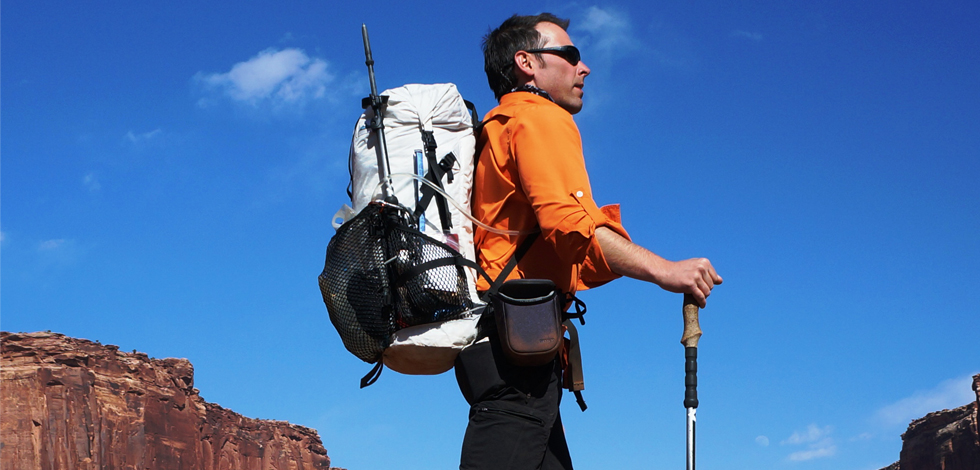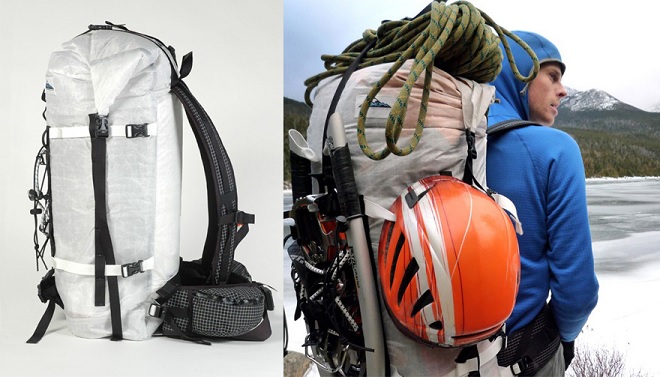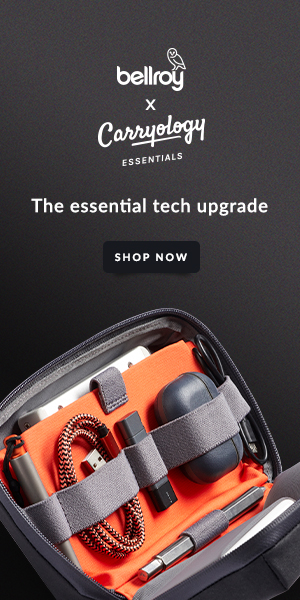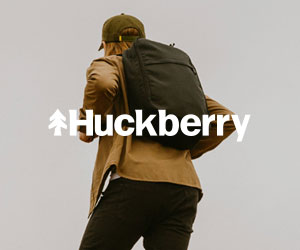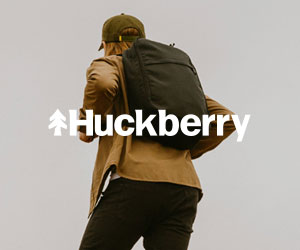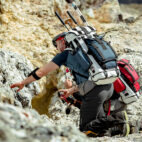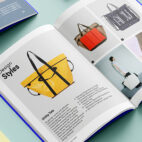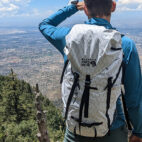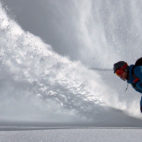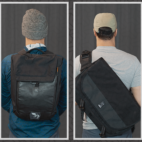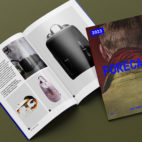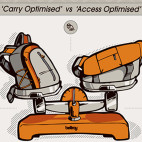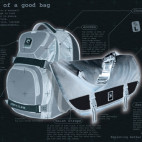Core77 Ultralight series :: Part 2
Following on from their introduction post to ultralight backpacking, Core77 dug down into the details courtesy of an interview with Mike St. Pierre. Mike is the founder of Hyperlite Mountain Gear, a brand that prides itself on making ultralight and lightweight packs, shelters and accessories. Check out the interview Unpacking “Ultralight” with Mike St. Pierre of Hyperlite Mountain Gear by Kat Bauman in full below.
–
This is the first of a multi-part look at lightweight backpacking and the designers who love it.
Ultralight is a challenging niche within both the outdoor community and the outdoor industry. Ultralight users are often out on the trail or mountain for weeks on end, and ultralight designers have to get them there and back. To learn about the passions and problem-solving involved, I spoke with Mike St. Pierre, founder of Hyperlite Mountain Gear, makers of award-winning ultralight packs and tents.
C77: What inspires you to create new designs?
Mike: Honestly? My own personal interest level in an outdoor activity. I started out making packs for backpacking and through-hiking because I was doing a lot of that, then I got into climbing, so I made packs for climbers. Then I got into backcountry skiing – so that’s probably one of the next products. New designs come from personal interest and from customers requesting products for niches where they want to go lighter.
How do you determine desired weight and work towards it?
We don’t set out with that goal in mind. Weight is important, but I’ve never been looking to be the lightest guy out there. The weight is a byproduct of the design philosophy: strip away and provide the basics of what you need. A lot of companies build bags that have a multitude of attachment points, bags for doing all kind things – one bag fits all. We don’t look at it that way, it’s good to be specific. Rock climbing? Climbing bag. Ice hiking? Ice hiking pack.
How do developments in high-tech materials impact your line of products and new designs?
When I found out about cuben fiber it was a no brainer. It’s truly waterproof, the strongest material in the world, it’s non woven. All the other fabrics out there are coated fabrics. Instead you’ve got something that won’t leak, weighs less… It’s the best. So we’re always searching for the newest modern materials. More minimalist designs mean more high tech materials. Marrying the two is how we reduce the weight. Stick with what works, but sometimes you find something exciting that can spark a whole new line.
I had a heavy hand in the development of a lot of fabrics that we use. We’re doing our own production here in Maine – when we started no one was willing or had knowledge of the adhesives and bonding techniques involved. I shopped it around, and decided there was no way to do it unless we build out manufacturing ourselves. Our cuben fiber with laminated woven fabrics, those are products fabrics I had my two cents in with our developers. I constantly find things I like somewhere, and find a way to get it laminated or incorporated in the manufacture of the cuben.
How does your design process address ergonomics?
To begin with it was all trial and error. People will tell you there are standards in this industry, REI et al each have their own measurement system – none correspond to the numbers of the actual packs. They just use that to sell stuff, it has nothing to do with reality.
I build almost entirely by hand. People build these 3D models of your bags in these programs. In the time you build that model in that program, I can build a physical sample. We’ve gotten somewhat digitized now, but for something new you have to rough it together and refine it from there. Once we get an idea, we build a crude prototype by hand and go from there, refining all the way. The design team is me. We’re working towards a bigger R&D department of several people.
Manufacturing for ourselves makes us unbelievably nimble. One of us on the staff goes out over the weekend and comes back wanting to change something to make it work better, and we can. If something doesn’t fail I get nervous. We’ve also got athletes in the field. The higher they go on mountains the more we see problems, and I can make that change next day. We couldn’t be innovative if we were shipping containers around the world.
By not making containers of stuff out in Asia and trying to sell it all out before we can change, that’s great. We can make changes and make sure the customer gets the most up to date, quality products. I still use everything we make, unlike bigger companies run by suit and tie guys who aren’t even out in the outdoors. And the big companies have a huge barrier to entry in innovative gear and new materials, given the apparatus. We don’t have the same overhead.
Eddie Bauer launched a cuben fiber backpack, it’s double the weight of ours and double the price!
At what point does aesthetics enter the design process?
It’s definitely a consideration, but lower on the priority list. That’s the nature of design, I wouldn’t design things that end in la-la land. But it can’t look unfinished, gotta look polished. The nature of making things functional, simple always seems better. In the back country that’s hugely important, if something fails…the simpler things are the easier they are to fix. That’s another consideration, even if our product fails you’re never going to have catastrophic failure – you’ll still be able to be safe, warm, whatever.
Which end-users specifically inform your product development?
It all starts with me. I get a new interest…it’s hard to design something I don’t use. Everything in the line is something I use in my personal activities. That seems to resonate with our customers, and the industry, I guess.
Being able to go out and realize “That buckle doesn’t belong there, it belongs over here!” it makes it so much easier. I’m always pushing the limits of what I can do in the outdoors, it makes designing so much easier instead of relying on other people to give you the feedback on early concepts. The sky’s the limit, because everything out there is overbuilt and too heavy and every piece of use in the outdoors could benefit from our philosophy and approach.
What was the intention (or inspiration) that started your line of products?
Too much of this industry is all the same people, all in the same fishbowl talking to each other, recycling old ideas. I came out of left field with no design experience, no experience in the industry, but I love the outdoors and I’ve been in the backwoods my whole life. A lot of this industry is sales driven. The marketing department develops an idea, and THEN the product developers get it, which is totally backwards. We’ve had no formal marketing in this company to date. If you build a really good product – especially in this industry, where product is king – the sales will follow.
So which ideas should get thrown out?
Mostly the industry telling people what they need to have, when the industry doesn’t even use the products. That’s huge! These big companies pushing stuff, but how many of them have actually tried it? You can go to EMS for everything you need for a backpacking trip: you’ll walk out with 25 pounds of stuff! Metal match containers, cots, a shower! 60lb backpack for a two-day trip. There’s nothing fun about that! Same amount of stuff, the stuff you need, could be just 10-12 pounds. That’s a huge difference! I don’t need nine ways to attach an ice axe to my backpack.
At REI, all their buyers are really active and into it, “Holy shit we love your bag, I use your bag…we’d love to carry your stuff.” I set up a meeting, meet the pack buyer, she looks at the product and goes “There’s no way our customer would buy this: it needs more pockets and zippers.” You’ve missed the point!
Like minivans “needing” 16 cupholders.
Yeah. You don’t need that stuff! You’re going to have more fun, go farther, stay drier, have more fun! It’s a misconception. We’re a pretty direct to consumer company – maybe 15% of our business is wholesale. I think that’s telling. I’m here to disrupt this industry.
What other technical gear companies do you admire?
Any company with the same philosophy we have. It’s all about the product. If it’s good – if it does what they tell you it’ll do – that’s huge. If they’re not blowing smoke up your ass, tell you how it is, you get out there and it works. Sleeping bags and apparel: Westcomb, Rab has always been in my closet, I’m digging the new BD apparel [*Black Diamond, though I wish he’d meant this], just brought on a Valandre sleeping bag. Feathered Friends is a great bag company.
Getting lighter gear, I’ve been getting into multidiscipline adventures. Packrafting, where you hike in and raft, my base weight is about 10 lbs of gear. I’ve got a full whitewater boating setup for 22lbs for multi day. It’s a fine line between lightweight and durability, but at the end of the day it HAS TO WORK, it can’t be a throwaway product.
—–





 Carry Awards
Carry Awards Insights
Insights Liking
Liking Projects
Projects Interviews
Interviews
